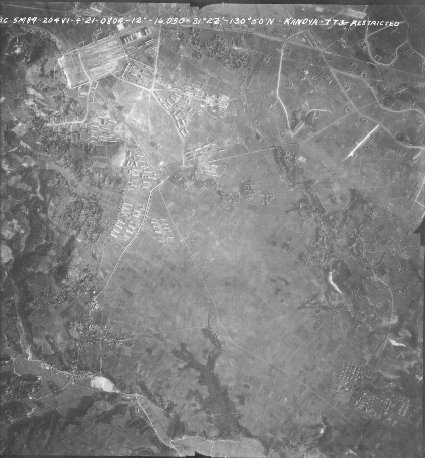


|
[Search Tip: Use " " for better search results ex. "John Q. Doe"; "City of ..."] |
||||||||||||||||||||||||||||||||||||||||
Following the night strike at Kawasaki, the 39th Bomb Group, along with other units of XXII Bomber Command, began the long series of attacks on the southernmost Japanese home island of Kyushu. In order to carry on those neutralizing attacks, it was necessary, for the time, to abandon the strategic plan to knock out systematically the major industrial cities of Japan one by one. It was the urgency of the situation at Okinawa that dictated the new bombing policy of the Command. Since the beginning of the American invasion of Okinawa, the United States Navy had been experiencing a great deal of trouble with damaging attacks by enemy planes and suicide aircraft based on Kyushu. The number of naval vessels thus hit was reaching such proportions that something had to be done about it. In this situation, the Navy called upon the XXII Bomber Command for help and got it. The Superforts placed a series of more than a dozen airfields on Kyushu, stretching all the way from Oita, Usa and Saeki on the north around the eastern shore to Izumi under almost daily attack.
Beginning with a strike at Kanoya airfield on 17 April, the 39th Group continued these raids until 5 May and flew a total of eleven missions of this sort. During this period there was but one break in the schedule of Kyushu airfield bombings. This break came on 23-24 April when a GP strike was made on the Hitachi Aircraft Factory, seventeen miles west of Tokyo. The long list of Kyushu missions was grueling for everybody concerned, but especially for the combat crews and the maintenance personnel. Sometimes the 39th would send out a maximum effort to target and on other occasions one or two squadrons would go. In the latter event, it was more than likely that before the first force had returned to base, the other planes were on the way to another target. On one occasion Intelligence was holding a debriefing on one end of the briefing room while the other end was being used to brief crews on the next strike. Except for the orderliness of the proceedings, the whole affair might have been called a rat race. In
all, the Kyushu raids stacked up like this: Kanoya was hit three
times, Kokobu twice, Kushu four times, Saeki once and Oita once.
Opposition varied a great deal. Sometimes the flak would actually be negligible and the fighters scarce and then at other times the enemy would put up a hot defense. On the flight to Kokobu on 26 April, the only flak reported by crews of the 39th were two bursts near Kanoya on the way to the target and one burst just after bombs away. Seventeen enemy aircrafts were seen airborne, but not one attack was made on the bombers. In connection with this strike, the crews like to tell a story. Kokobu was the training station for the Japanese suicide squadrons, the so-called "Kamikaze." According to the Nips' propaganda, these eager beavers wanted nothing better that to take to the air against the B-29s and, by their much heralded "body crashing" tactics, to ram the Superfortresses and then join their honorable ancestors wherever they were. But this time the little dare-alls showed just exactly how eager they were. It so happened that Kokobu was socked in 10/10ths. There were seventeen enemy fighters in the air - presumably some of the Kamikaze. But because of the cloud coverage, their antics could not be seen from the ground and not a one tried the well-known suicide system on our force. Maybe these particular buck-toothed boys subscribed to the old system saying that sometimes life just ain't worth living, but even at that it's a hell of a sight better than dying. |
 |
|||||||
6 |
6
|
||||||
Copyright © 2000 - 2025 - 39th.org|39thbombgroup.org

